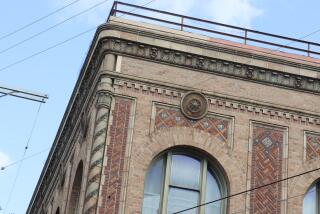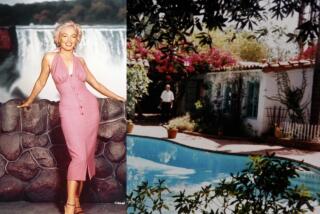Sierra Club Founder’s Birthplace Provokes Preservation Debate
- Share via
DUNBAR, Scotland — John Muir, the father of nature conservation in the United States, has become the focus of a battle over heritage preservation in the coastal town that inspired his love of the wilderness.
Fortunately, the “wild places and wild creatures” of Muir’s native Dunbar aren’t under threat, because a good stretch of the rich coastal land he roamed as a child has been safeguarded in the national John Muir Trust. Nor is the town’s historic High Street at risk: It looks much as it did when Muir was born there in 1838, save the Muir statue outside the town hall.
Rather, the issue for Dunbar is what to do with John Muir’s birthplace--the house where he entered the world and spent his first two years before moving next door and then, at age 10, immigrating to America.
Trustees of the birthplace plan to gut the three-story building--including the upstairs museum re-creating the Muir family flat--and install a modern educational center that would interpret the life of their native son, his pioneering work as an environmentalist and the work’s relevance today.
“This isn’t about bringing people to see where John Muir was born and what an 1840s house would have looked like,” trustee Norman Hampshire said. “We want to use that place to promote what he achieved in life. . . . We want to preserve the heritage of John Muir, his life and the story of conservation.”
Graham White, a local author of four books on Muir, is leading the opposition to the remodeling, which he charged would “lose the essential character” of the building as a house and Muir family home.
“This is a historic watershed. Either it is going to be John Muir’s home, or it is going to be a visitor center with no historic connection to John Muir,” White said.
“It’s a Trojan horse,” said Dunbar town council member Daisy Hawryluk, who helped set up the existing museum and whose daughter sold the building to the John Muir Birthplace Trust. “Once they put a hammer to the walls, it’s too late.”
The clash among local keepers of Muir’s memory reflects a larger debate about the meaning of national heritage, the value of old buildings in preserving heritage and the way to make it all relevant to future generations.
This debate pits the Heritage Lottery Fund--which has given the birthplace trust nearly $420,000 and supports the innovative plan--against biographers and members of the Muir family in the United States who take a more traditional view of what the birthplace should be.
White has used the Internet to campaign against the renovation and solicit letters of protest (https://www.savejohnmuirhouse.org.uk). For their part, trustees (https://www.jmbt.org.uk) have received more than 100 e-mails, most of them from the United States, in opposition and support.
Although Muir has a reputation in the United States as the force behind the establishment of Yosemite National Park and a founder and first president of the Sierra Club, he is not widely known in his native Scotland. Both sides want to use the birthplace property to rectify this, but they disagree as to the best way.
Members of the birthplace trust say that little of the original building where Muir was born remains, because it was renovated in the 1970s, and that Muir only referred to the house once in his memoirs, when he recalled falling there and splitting his lip on the edge of a tub. There are no original family artifacts or clear descriptions of how the house was arranged when the Muirs lived there, trustees say.
The planned renovation, therefore, wouldn’t have an apartment like the one there now, decorated with Victorian period pieces to appear as it might have in Muir’s time.
Instead, the outer walls would be retained around a modern, three-story recessed structure. The exhibits, using video and computers as well as graphic panels and 3-D models, would explain Muir’s childhood in Dunbar and his journey to the United States; his adult travels and development into an environmental advocate; and his philosophy, teachings and legacy.
“If the building had contained any historical evidence and fabric of heritage value to restore the house, we may well have taken that approach. But it didn’t,” said Edinburgh designer David Campbell, who is creating the interior and exhibits.
“I think it would be disappointing to travel 5,000 miles [from the United States] to see someone else’s guess at what it might have looked like in the past. . . . Rather than confuse the public with fake heritage, we have decided to separate what is original from what is new,” he said.
“New” can be seen at home on the Internet, critics argue. What visitors to the Muir birthplace want is a hands-on experience in the 19th century house where Muir lived, the feel and smell of life in the 1840s, the hardships the Muir family experienced while crammed into the small flat where it lost seven infants to then-incurable diseases, they say.
“You can describe an apple in text and exhibits, but you have to eat the apple to know what it’s like,” White said. “For a schoolchild to handle a big smoothing iron and feel how heavy and dangerous it was, to see a chamber pot under the bed or to see that you have to go 100 yards down the street to fetch water, that’s education.”
To make his point, White clambered up the ruins of a 16th century castle where Muir played as a child, home now to scores of gulls and their young. He pointed to a seal bobbing in the sea, to the coast where Muir would have walked with his grandfather on weekends and to several of the 160 species of birds that live in the area--part and parcel of the world that inspired Muir.
But for Jim Thompson, chairman of the Dunbar John Muir Assn., the scenery helps make the case for the renovation project he supports.
“The spiritual experience is not here in the house. It is out there, walking the streets, seeing the beach and the castle that Muir climbed on, standing at the graves of his grandparents,” Thompson said. “It’s Dunbar.”
Students and other visitors to the birthplace need a clever and innovative presentation of Muir’s ideas that will grab them intellectually, said Liz McLean, architectural advisor to the project for the regional East Lothian Council. “They should come through the door and say, ‘Ah, gosh, wow.’ ”
The renovation plan is to be submitted to the council’s planning committee at the end of the month. If approved, it will be reviewed by Historic Scotland, a department of the Scottish Executive, which looks at the uses of all of the country’s 47,000 “listed” historic buildings.
Historic Scotland cannot comment on a proposal before officially considering it. In general terms, however, spokesman Pat Connor said that heritage sites frequently undergo radical changes, from conversion to gutting.
“Listing a building is not done to preserve it in aspic. Listed buildings have to earn their keep,” Connor said. “It is not designed to prevent change, but to manage it.”
More to Read
Sign up for Essential California
The most important California stories and recommendations in your inbox every morning.
You may occasionally receive promotional content from the Los Angeles Times.










